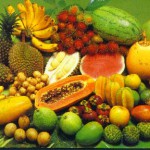Australia: Issues With Irradiation
 In Australia, herbs, spices, herbal infusions (teas), nine tropical fruits (mango, paw paw, lychee, longan, mangosteen, rambutan, carambola, breadfruit and custard apple), persimmons, tomatoes and capsicums have so far been approved for irradiation.
In Australia, herbs, spices, herbal infusions (teas), nine tropical fruits (mango, paw paw, lychee, longan, mangosteen, rambutan, carambola, breadfruit and custard apple), persimmons, tomatoes and capsicums have so far been approved for irradiation.
There are 16 further approvals in the pipeline, including: zucchinis, honey dew melons, rockmelons, nectarines, strawberries, cherries, apricots, plums, peaches, table grapes, and apples.
In the US, numerous products, including beef, vegetables, oysters and fruit may be irradiated. Free trade agreements make it likely that more approvals will be pursued in Australia.
Irradiated products are difficult for consumers to identify, as labelling requirements are inadequate. Non-packaged products are not individually labelled. Cereal grains fed to animals, bee hives, and pet food may be irradiated without labelling as they are not classified as “food.”
There are many reasons to go irradiation free. These include the health risks associated with irradiation, the social and environmental impact of the irradiation industry, the fact that numerous alternatives exist, and the ethics of supporting the irradiation industry.
Heath risks associated with irradiation.
In 2008, up to 100 Australian pet cats suffered neurological disease linked to eating irradiated cat food. In 2009 over 300 dogs in the US died from food linked to irradiation.
The Australian government has since banned the irradiation of cat food, but continues to expand the list of foods permitted to be irradiated for human consumption.
Numerous scientific reports have highlighted health risks associated with irradiation. Irradiation changes the molecular structure of food, forming toxic chemicals linked to genetic mutations, vitamin deficiency, immune system disorders, tumors, stunted growth and reproduction problems.
For example:
- Ionising radiation creates new chemicals called “radiolytic products’, some of which do not occur naturally in food. These have not been adequately studied. One of them, 2-ACBs, has recently be found to promote the cancer-development process in rats, cause genetic damage in rats and cause genetic and cellular damage in human and rat cells. (1)
- Irradiation destroys and disrupts vitamins, proteins, essential fatty acids and other nutrients in food – sometimes significantly. It can destroy up to 80 percent of vitamin A in eggs and 48 percent of betacarotene in orange juice. (2)
- Irradiation masks poor production practices. Irradiation can kill most bacteria in food, but it does not remove the feces, urine, pus and vomit that often contaminate meat or the pests, feces, or other matter that may contaminate herbs, spices, or fruit and vegetables.
- Free radical overload in irradiated foods can lead to: Lowered immune resistance, upsurge in abnormal lymph cell, decreased fertility, damage to kidneys, depressed growth rates, and deficiencies in vitamins A, B, C, E and K. (3)
